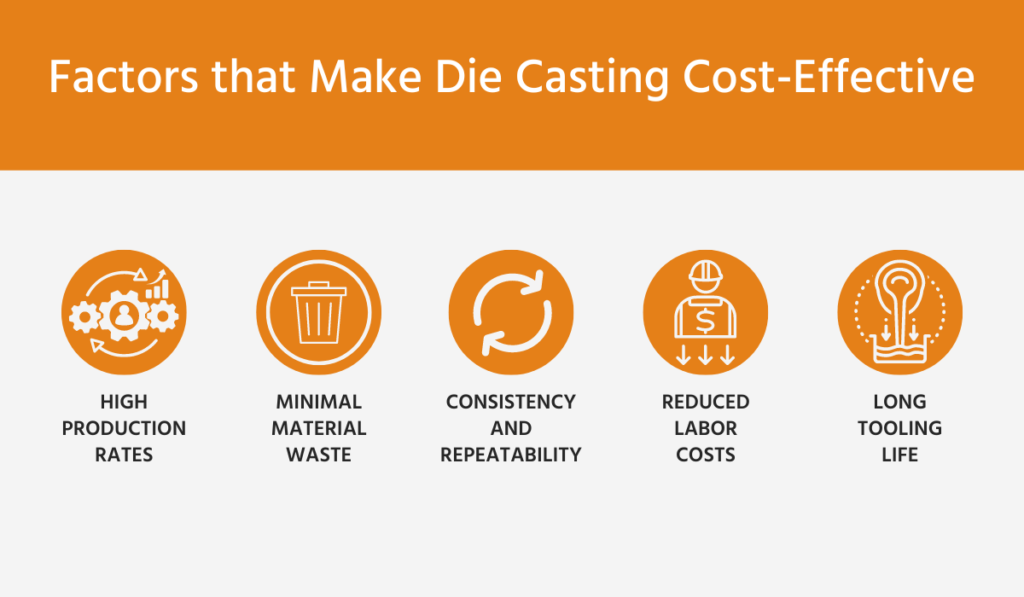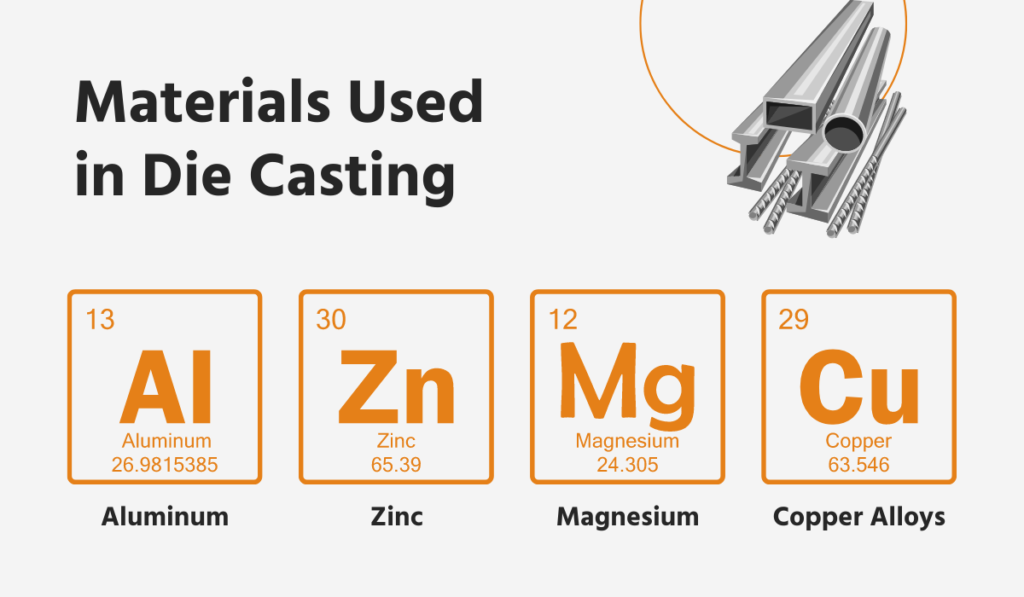Die casting can produce large quantities of parts with high precision, accuracy, and repeatability.
On top of that, it is capable of creating complex shapes and thin walls, which are often difficult to achieve with other casting methods.
Such capabilities have made this manufacturing method a popular choice for businesses operating in industries that rely on such benefits to produce high-quality metal parts, all while remaining competitive within their respective industries.
In this article, we are going to discuss five major advantages of the die casting process.
This knowledge could not only help you determine whether this casting process would be a good fit for your custom metal parts project, but also whether it could give you a competitive advantage over other businesses within your industry.
Die casting cycles are incredibly short, often lasting only between a few seconds to one minute.
This rapid turnaround time allows manufacturers to produce parts efficiently and meet tight production schedules.
What makes this possible is the use of high pressure.
Namely, molten metal is injected into the mold cavity with great force and at high speeds, allowing multiple identical casts to be produced in a short amount of time.
Another major factor for die casting’s high production rates is the speed at which the molten metal cools within the mold.
When molten metal is injected into the mold cavity, it begins to solidify almost immediately upon contact with the relatively cooler surfaces of the mold.
The rapid solidification that occurs during die casting is due to the high thermal conductivity of the mold material, which helps draw heat away from the molten metal and allows it to cool significantly faster than would normally be possible using other manufacturing techniques.
Die casting’s combination of high pressure and efficient heat transfer within the mold ensures that the molten metal fills the mold quickly and evenly, resulting in a short cooling time for the metal.
This, in turn, reduces the process’s cycle time (i.e. continuous production with minimal downtime).
The process’s fast cycle times translate directly into higher production rates, which is one of the main reasons why manufacturers choose it when they need to cast a large number of identical components in a short amount of time.
Furthermore, the die casting process is highly precise and efficient.
Die casting molds are crafted with such meticulous attention to detail that they can cast the final product to exact specifications.
Since the molds used in die casting can be designed to capture every contour and feature of the desired part, they can cast intricate geometries and fine details onto those parts better than many other manufacturing methods.
The high pressure used in die casting also helps in increasing dimensional accuracy.
Namely, it forces the molten metal into every nook and cranny of the mold, ensuring complete replication of parts with exceptional accuracy straight out of the mold.
Die casting can be customized to accommodate a wide range of complex shapes and configurations.
The high dimensional accuracy the process offers is not limited to only one-time casts either, as it can produce specific shapes and sizes repeatedly and consistently without any deviation.
Once the mold is set up and the process parameters are dialed in, each casting cycle produces parts that are virtually identical to one another.
This consistent replication is essential for applications where tight tolerances are required, such as those found in the automotive and aerospace industries.
As an added benefit, die casting also allows for the reduction in the need for secondary machining operations, which helps save time and resources, as well as helps maintain the integrity of the part’s original design.
Once the initial tooling and molds are created, die casting becomes a highly cost-effective choice for large production runs.
Even though the initial setup costs for tooling and molds can be significant, die casting is still a cost-effective manufacturing method for large-volume production.
Five factors are responsible for the process’s reduced costs over large runs.

Source: Bunty LLC
1. High Production Rates: Die casting’s fast cycle times allow for rapid production of parts.
Once the molds are set up, the process can churn out large quantities of parts in a relatively short amount of time.
This high throughput translates directly into lower per-unit costs, as the fixed costs of tooling and equipment are spread out over a greater number of parts.
2. Minimal Material Waste: Die casting minimizes material waste by precisely measuring the molten metal and injecting it through high pressure into the molds, which results in minimal excess material.
3. Consistency and Repeatability: Die casting offers excellent repeatability and consistency from part to part.
Once the process parameters are dialed in, each casting cycle produces parts that meet the same stringent specifications.
This consistency reduces the likelihood of defects and rework, saving time and resources in the long run.
4. Reduced Labor Costs: Compared to other manufacturing processes that often require extensive manual labor or post-processing, die casting is relatively automated.
Once the molds are set up and the process is running smoothly, the need for manual intervention is minimal.
This automation helps to reduce labor costs associated with production.
5. Long Tooling Life: Die casting molds are typically made from durable materials such as steel, which offer long service lives.
With proper maintenance and care, die casting molds can last for thousands or even millions of cycles, amortizing the initial tooling costs over a vast number of parts.
In short, die casting’s ability to produce large quantities of high-quality parts efficiently makes the process a cost-effective manufacturing method for industries that require large production runs for their custom metal parts.
One of the biggest advantages of the die casting process is its ability to produce parts with exceptional surface finish.
The surfaces of die-cast parts are so smooth that they often do not require any additional finishing processes.
But even when they do, the finishing options are relatively minimal and easy to implement.
The main reason for die casting’s ability to produce outstanding surface finish is its employment of rapid cooling of the molten metal within the mold, which results in parts with fine details and smooth surfaces straight out of the mold.
Some of the other specifics of how the process achieves such an excellent surface finish are as follows:
1. High Precision Molds: Die casting molds are crafted with meticulous precision, ensuring that every detail of the desired part is captured accurately.
The smooth surfaces of the mold are transferred directly to the cast part, resulting in a flawless finish.
2. Low Turbulence Injection: The high pressure used in die casting forces the molten metal into every corner of the mold cavity, which helps minimize turbulence during the injection process.
This controlled filling ensures that the metal flows smoothly and evenly, reducing the likelihood of defects such as porosity or surface imperfections.
3. Fine Grain Structure: The rapid cooling of the molten metal within the mold leads to the formation of a fine-grain structure in the cast part.
This fine grain structure contributes to a smoother surface finish, as it reduces the visibility of any imperfections or irregularities.
4. Minimal Draft Requirements: Unlike other manufacturing processes that may require significant draft angles to facilitate part ejection from the mold, die casting often allows for minimal draft requirements.
This means that the final part can have near-vertical walls and sharp corners, further enhancing its aesthetic appeal and surface finish.
5. Reduced Need for Secondary Finishing: Due to the excellent surface finish achieved through die casting, many parts can be used directly from the mold without the need for secondary processes such as sanding, grinding, and polishing.
Reducing the need for additional processes not only saves time but also reduces the overall production costs associated with post-processing.
All of this makes die casting a more cost-effective and efficient solution for industries like aerospace, automotive, and medical, which require impeccable surface finish for their components, systems, and products.
When it comes to material selection, die casting offers a wide range of options.
Having more material options allows manufacturers to tailor their components to meet the exact needs of their clients.
Additionally, it empowers them to strike the perfect balance between strength, weight, and cost, thereby helping produce a better final product at a lower cost.
Some of the metals that the process can accommodate along with their unique properties and advantages include the following:

Source: Bunty LLC
1. Aluminum: Aluminum is one of the most popular materials used in die casting.
This is largely due to its excellent strength-to-weight ratio, corrosion resistance, and thermal conductivity.
Aluminum is commonly used in automotive components, electronic enclosures, and consumer goods where lightweight and durable parts are needed.
2. Zinc: Zinc offers excellent casting properties, including high fluidity and low melting temperatures, making it well-suited for intricate and complex parts.
Die-cast zinc components are prized for their precision and dimensional stability and are ideal for applications such as automotive parts, hardware, and decorative fixtures.
3. Magnesium: Magnesium boasts the highest strength-to-weight ratio of all commonly used metals, making it ideal for applications where lightweight and high-performance parts are essential.
Die-cast magnesium components are commonly found in aerospace, automotive, and electronics industries, where weight reduction is critical for fuel efficiency and performance.
4. Copper Alloys: Copper alloys have excellent conductivity, corrosion resistance, and thermal properties. which makes them extremely suitable for applications such as electrical connectors, heat sinks, and plumbing fixtures.
Die-cast copper alloy parts are known for their durability and reliability in demanding environments.
The broad range of metals that can be used in die casting allows manufacturers to choose the material that best suits the specific requirements of almost any project.
Whether it’s optimizing for strength, weight, corrosion resistance, or cost, the process can offer a material solution to meet virtually any manufacturing need.
Understanding the key advantages of die casting outlined in this guide is important for both manufacturers and businesses in need of custom metal parts.
Knowing the benefits the process can potentially bring to a metal parts project can help streamline the entire process, enhance product quality, and optimize costs.
As important as knowing the advantages die casting can bring to your project is, of equal importance is to get in contact with metal manufacturers who have the experience and expertise in working with this method, as well as other manufacturing processes that could improve your casting efforts.
Doing so will help ensure a quality final product at a cost-effective price.
From a contract manufacturing firm, BuntyLLC evolved into a full service custom machined, forged and cast metal parts fabrication enterprise. We supply global solutions from our headquarters in Greenville, South Carolina.
Get A Quote